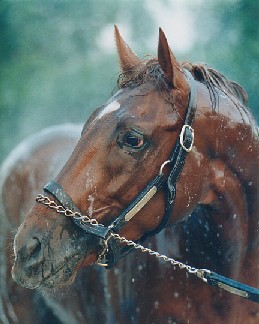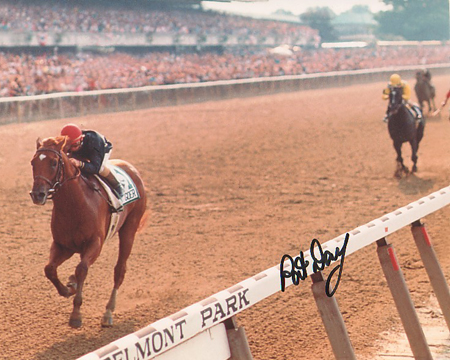  Easy Goer Easy Goer
"Bred to be a Champion", The Look of Eagles
Everyone dreams of the Big Horse, the one who will do what no other has done, who will blaze across the track in a flame of greatness. In the fall of 1988, it seemed certain that the next Big Horse was here.
He was a chesnut colt by Alydar, out of the champion mare Relaxing, herself sired by the great Buckpasser. No pedigree could be more perfect, no blood bluer. This big, red, muscular colt was bred to be a champion, and he ran like won. His name was Easy Goer.
Easy Goer lost his first race, then rattled off a skein of wins in some of the most prestigious 2-year-old stakes in the country: the Champagne, the Futurity, the Sanford. He went into the Breeders' Cup Juvenile-G1 not only the favorite for that race, but the future book favorite for the next year's Kentucky Derby. Unfortunately, the Breeders' Cup was held at Churchill Downs that year, and it had rained. The one thing that Easy Goer detested above all was the mud of the Downs. Like 1998 Horse of the Year Skip Away, Easy Goer was on of those horses who just does not like the track at Churchill Downs. He finished second to Is It True in the Juvenile, running very well for a horse who was not comfortable on the track.
At three, Easy Goer was better than ever. He won the 7 furlong Swale Stakes, followed by the 1 mile Gotham Stakes at Aqueduct, breaking Secretariat's stakes record in the process. He was no longer just the favorite for the Derby, he was odds on to win the Triple Crown. Memories of other big red colts flashed in everyone's mind as he demolished the Gotham. Man o' War, Secretariat ... was Easy Goer the next Big Red?
His Derby prep, the Wood Memorial Stakes, was a winning one, but in the meantime, a black colt named Sunday Silence had won the Santa Anita Derby by 11 lengths. Still, no one doubted the class and ability of Easy Goer, and he went off the odds-on favorite in the Kentucky Derby, despite the fact that the track was muddy. It was simply expected that the colt would so outclass his rivals that he would easily overcome his disdain for the footing. But it was too much to ask of him. Even great horses have faults, and this was one of Easy Goer's. He ran a very good race, but finished 2 1/2 lengths behind Sunday Silence. The racing world was stunned.
Two weeks later, the black and the chestnut faced off again in the Preakness Stakes. The track was fast and Easy Goer was once again the favorite. As the field turned for home, Easy Goer was on the rail, with Sunday Silence glued to his outside. They ran down the stretch together, head and head, both fighting to beat the other to the wire. It was debated at the time (and still is) that Easy Goer would have won that race if his jockey, Pat Day, had not turned his head to the right. Day claimed he turned the colt's head so that he could see his rival better, but many (myself included) feel that if Easy Goer had been able to run straight and true, with his head out, he would have had the nose ahead at the wire. But that is all in the realm of "what if" and the fact is, Sunday Silence hit the wire a nostril ahead of Easy Goer, and was two-thirds of the way to the Triple Crown.
The tables were turned, and in the Belmont Stakes three weeks later, it was Sunday Silence who was the favorite. But Belmont Park was Easy Goer's backyard, and his bigger build (Sunday Silence was a thinner colt) was suited perfectly to the wide sweeping turns of the 1 1/2 mile oval at Belmont. Besides, Easy Goer was bred to go 1 1/2 miles, something very few horses are these days. The Belmont Stakes was made for him.
As they turned for home, it looked like a replay of the Preakness again, a flashback to 1978 when Easy Goer's sire Alydar fought vainly to deny Affirmed his Triple Crown. But in one instant, that vision vanished. Easy Goer came up alongside of Sunday Silence and in one stride, he put him away. As the black colt tried to keep up, the big chestnut pulled away, winning easily by 8 lengths, with the second fastest time in the history of the Belmont. Only Secretariat ran it faster. Easy Goer was back on top.
The two rivals parted for a time, Sunday Silence returning to California, where he ran second to Prized in the Swaps Stakes, then shipped to Louisiana to win the Super Derby. Easy Goer stayed in New York, going to Saratoga to beat older horses in the Whitney Handicap as a prep for the Travers Stakes, his last race against 3-year-olds, which he also won. He then returned to Belmont Park to win the Woodward Stakes (then at 1 1/4 miles) and the Jockey Club Gold Cup (still run at 1 1/2 miles at that time). He went into the 1989 Breeders' Cup Classic at Gulfstream Park as the favorite.

The turns at Gulfstream are fairly sharp, and as a big, long striding horse, Easy Goer gave the edge to the slimmer, more nimble Sunday Silence. The black colt got the jump on him and had a clear lead as they came down the stretch. But Easy Goer kicked it into gear, closing with every stride. Two jumps past the wire, he caught his rival, but it was too late. Racing luck had cost him the win; if he had been able to make his final run a bit earlier, he could have caught Sunday Silence at the wire.
Ironically, Easy Goer won more Grade One races than any other male horse that year, but didn't win a single championship. In the "good old days", before the Eclipse Awards were created, the top older horse award was called "Champion Handicap Horse". The Eclipse Awards are based on age classifications. There was only one award Easy Goer was eligible for: Champion Three-Year-Old. Sunday Silence got that one. Champion Older Male went to Blushing John, who had been beaten soundly by the youngsters in the Classic. Had the awards been written differently, Easy Goer could have (and should have) been named Champion Handicap Horse of 1989.
As a four-year-old, Easy Goer won the Gold Stage Stakes in his debut, then ran third in the Metropolitan Handicap-G1 to champion sprinter Housebuster and eventual 1990 Horse of the Year Criminal Type (a fellow son of Alydar). Next, he won the Suburban Handicap-G1 at 1 1/4 miles and it looked like he and Sunday Silence (who had won the Hollywood Gold Cup-G1 in California) were headed for another rematch at Arlington Park in Chicago when Easy Goer was retired due to an injured ankle. Not long after, Sunday Silence too was injured and both colts left the track to start a new rivalry as stallions.
Easy Goer had all the advantages: a perfect pedigree, wonderful conformation (except for questionable knees) and the prized stall at Claiborne Farm. Bold Ruler had lived in that stall, then his son Secretariat. After Secretariat died in the fall of 1989, his stall had stood empty, waiting for a stallion worthy of it. Easy Goer moved in in 1990 and stood his first year at stud in 1991. Sunday Silence, meanwhile, was virtually ignored by the breeders in Kentucky and ended up going to Japan, where he has been the leading sire just about every year.
In the spring of 1994, when he had only three crops of foals on the ground, and one more on the way, Easy Goer was in his paddock at Claiborne and his groom, leading a tour, called him over. The big red stallion came to the gate, walked out of the paddock, then collapsed and died at the young age of eight.
Autopsy showed that Easy Goer died of anaphylactic shock. This tragic and sudden death was in fact a blessing in disguise: the horse was riddled with cancer cells and would have died soon at any rate.
The following year, Easy Goer's daughter My Flag won the Breeders' Cup Juvenile Fillies-G1 and was named Champion Two-Year-Old Filly for 1995. Her dam was Easy Goer's stablemate, Personal Ensign. My Flag ran in the 1996 Belmont Stakes-G1, the race her sire won with such authority, and she ran well to finish third against the top colts in the country.
Easy Goer also sired the good horses Will's Way (who won the Travers Stakes-G1 and Whitney Handicap-G1 just like his sire, defeating horses like Skip Away and Formal Gold) and Composer. He is also the broodmare sire of the stakes placed colt Desert Hero, who recently had the distinction of being jockey Gary Stevens' last mount.
Although he did not live up to all the expectations heaped on his strong chestnut back, Easy Goer did more than most horses do in a lifetime in his short eight years. He won stakes at distances of 7 furlongs to 1 1/2 miles; he won a Classic race; he sired a Breeders' Cup winner; he sired two Grade One stakes winners. And more important, he gave us all a little glimpse of what is possible, in the Gotham and the Belmont. His bright red coat gleamed with the shining promise of Greatness and no one can say he disappointed us.
Easy Goer
|
| Year |
Age |
Starts |
1st |
2nd |
3rd |
Earned Usd |
| 1988 |
2 |
6 |
4 |
2 |
0 |
697,500 |
| 1989 |
3 |
11 |
8 |
3 |
0 |
3,837,150 |
| 1990 |
4 |
3 |
2 |
0 |
1 |
339,120 |
| Totals |
20 |
14 |
5 |
1 |
4,873,770 |
Easy Goer's Pedigree
Easy Goer
1986 |
Alydar |
Raise a Native |
Native Dancer |
| Raise You |
| Sweet Tooth |
On-and-On |
| Plum Cake |
| Relaxing |
Buck Passer |
Tom Fool |
| Busanda |
| Marking Time |
To Market |
| Allemande |
|
